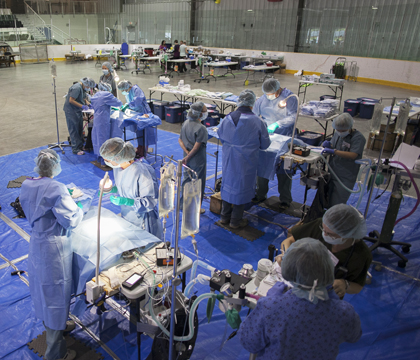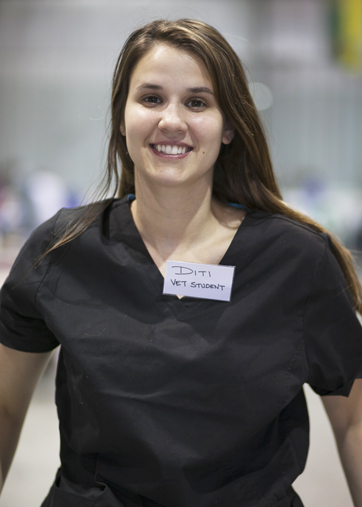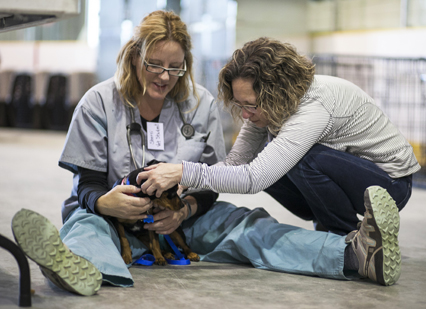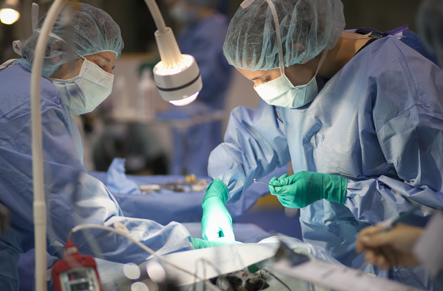
Community clinic fulfils vital health role
Out on the hockey rink's cement surface, a masked, blue-gowned veterinary student carefully unwraps a package of sterile surgery equipment. A veterinarian, also in surgical scrubs, gives her directions. Six identical tables are prepped and waiting for their feline and canine patients.
By Christina WeeseSoon after, there's a quiet flurry of activity as the weekend's first wave of spay and neuter surgeries begins inside La Ronge's Jonas Roberts Memorial Community Centre. The four-day clinic, which is taking place in early September, has attracted dozens of pet owners from La Ronge, Air Ronge and the Lac La Ronge Indian Band.
"It's an opportunity to experience veterinary medicine in an area where you don't necessarily have access to everything you would find in a hospital," says Diti Antonopoulos, a fourth-year veterinary student from the Western College of Veterinary Medicine (WCVM).
"This morning we spayed or neutered 30 cats — that's a huge deal here. And surgery is hard. It's very rewarding, but it's exhausting."
Antonopoulos and seven of her classmates are taking part in the veterinary college's new remote clinical practice rotation that aims to give students experience in delivering veterinary services in remote, rural and indigenous communities.
The rotation combines classroom components with actual field service work over a two-week period. Besides preparing for the clinical aspects of the weekend, the veterinary students have participated in a cultural awareness seminar highlighting the history and culture of Saskatchewan's First Nations people.

During their stay in La Ronge, the students spend a half-day in the clinic's wellness area where they examine incoming patients, give vaccinations and conduct pre-surgery checkups.
Among their visitors is Edna Mirasty and her grandchildren, Ada and Andrew. They have brought their three-month-old kittens, Thunder and Lightning, for a wellness check that includes vaccinations and deworming.
Mirasty, who is from the Bell's Point Reserve near La Ronge, says it means a lot to have animal health services come to their community.
"We've had pet clinics (here) before and we've been to every one of them," says Mirasty. "It's so awesome to see a vet coming at least once a year — twice a year sometimes — to help out with the animal population and maintain pet health.
"The more people know about this, the more they'll bring their pets to be checked out."
Veterinary students spend another half day monitoring anesthetized patients. They also participate in a full day of surgery, working alongside volunteer veterinarians and veterinary technologists from WCVM and private practices throughout Saskatchewan.
Dr. Jordan Woodsworth is the wellness veterinarian at the WCVM Veterinary Medical Centre and lead organizer of this spay-neuter clinic.
"It's a bit of a logistical nightmare to get things organized, especially the first couple of times," says Woodsworth.
"We needed to figure out all the supplies we need, how many people to bring, how we're going to do our appointment scheduling, record keeping, billing, how to get things organized in the community here — it's a big undertaking."
Planning began a year ago, with a volunteer team doing a trial run in May 2014.

"This time around we had the added challenge of making it a rotation, to create learning objectives and a structured learning format prior to arrival," says Woodsworth.
While volunteers performed 65 spay and neuter surgeries in May, Woodsworth expects to complete about 90 surgeries this weekend. That number includes 30 feral cats that will be rehomed by Alley Cat Allies whose involvement was arranged by Northern Animal Rescue (NAR).
With no local veterinarian or SPCA, NAR helps to fulfil the need for animal services in the community.
"People often contact us with questions about their pets' injuries or illness, and we help them figure out what options are available to them," says Joanne Dickson, founding board member of NAR.
"We're working on being able to offer educational programs in the future. The veterinarians who come here would like to go into the schools as well."
NAR rehomes between 450 and 500 animals from the La Ronge area each year. Dickson estimates that less than one per cent of NAR's rescues are humanely euthanized due to illness or aggression. The group hopes that initiatives such as spay-neuter clinics will eventually help to reduce the number of unwanted animals.
The Lac La Ronge Indian Band Council has been instrumental in bringing the clinic to the community. In addition to providing a facility at no cost, the council organized fundraisers to supplement veterinary fees for any families that have their animals licensed with the band.

"The hospital in La Ronge donated oxygen for the surgeries and transported it to the community with its regular shipment. We also received monetary and in-kind support from the band, the town and the village," notes Woodsworth. "And Northern Animal Rescue has made financial contributions from their fundraising efforts."
The WCVM also received significant donations of animal health products, pet food and money from Zoetis Canada, Boehringer Ingelheim Canada, Bayer Animal Health, Vétoquinol Canada, Purina and Ethicon.
As well, the WCVM and the University of Saskatchewan provided funding for the mobile trailer that has been converted into a mobile clinic.
For veterinary students, hands-on experience is only part of the reward.
"Being able to interact with the community has been great," says fourth-year student Christie Braaten. "It's also rewarding to help provide care for a community that normally doesn't have access to services like this and knowing that your work is appreciated."
"It's not only that we're getting opportunities to learn from the experience; it's a chance to give back," adds Antonopoulos. "For me, I knew it would be a great learning opportunity, but also I feel like we're making a huge difference in the community."
Antonopoulos hopes that the remote clinical practice will continue to be offered as a rotation option for WCVM students.
"I would definitely go home and encourage others to do this."
